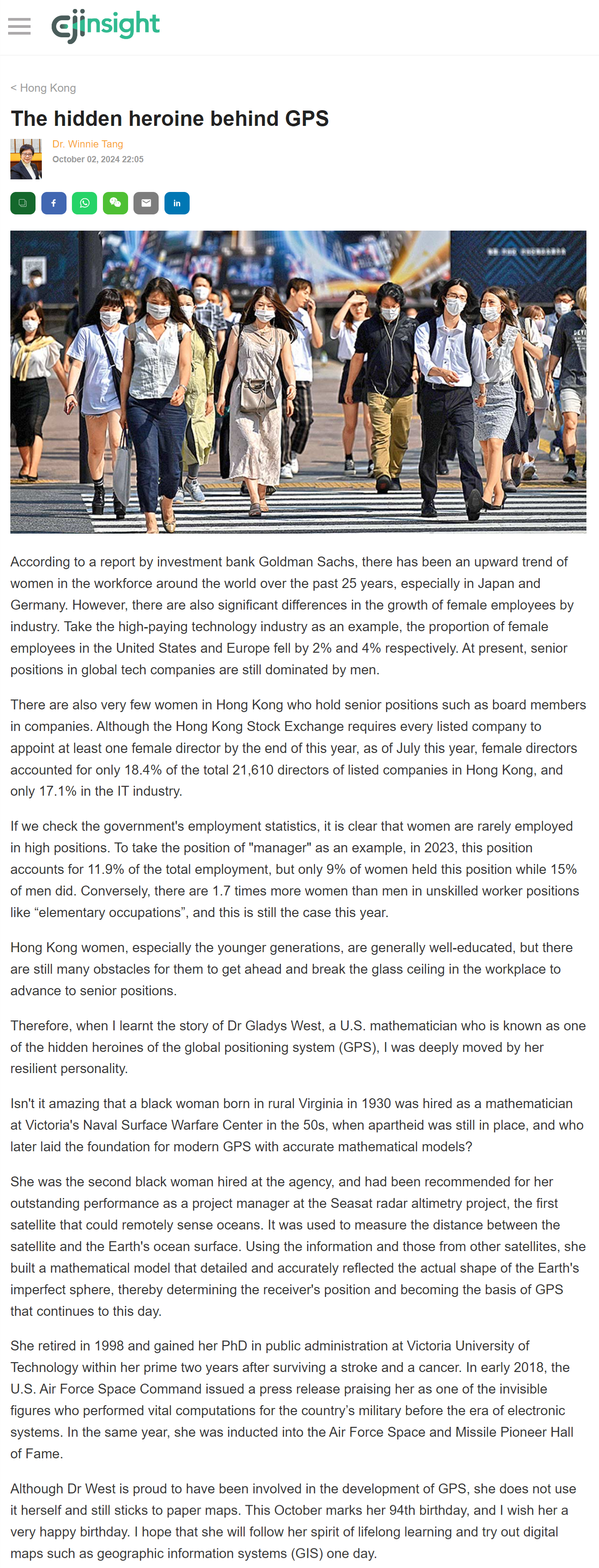網上版請按此

The hidden heroine behind GPS
According to a report by investment bank Goldman Sachs, there has been an upward trend of women in the workforce around the world over the past 25 years, especially in Japan and Germany. However, there are also significant differences in the growth of female employees by industry. Take the high-paying technology industry as an example, the proportion of female employees in the United States and Europe fell by 2% and 4% respectively. At present, senior positions in global tech companies are still dominated by men.
There are also very few women in Hong Kong who hold senior positions such as board members in companies. Although the Hong Kong Stock Exchange requires every listed company to appoint at least one female director by the end of this year, as of July this year, female directors accounted for only 18.4% of the total 21,610 directors of listed companies in Hong Kong, and only 17.1% in the IT industry.
If we check the government's employment statistics, it is clear that women are rarely employed in high positions. To take the position of "manager" as an example, in 2023, this position accounts for 11.9% of the total employment, but only 9% of women held this position while 15% of men did. Conversely, there are 1.7 times more women than men in unskilled worker positions like "elementary occupations", and this is still the case this year.
Hong Kong women, especially the younger generations, are generally well-educated, but there are still many obstacles for them to get ahead and break the glass ceiling in the workplace to advance to senior positions.
Therefore, when I learnt the story of Dr Gladys West, a U.S. mathematician who is known as one of the hidden heroines of the global positioning system (GPS), I was deeply moved by her resilient personality.
Isn't it amazing that a black woman born in rural Virginia in 1930 was hired as a mathematician at Victoria's Naval Surface Warfare Center in the 50s, when apartheid was still in place, and who later laid the foundation for modern GPS with accurate mathematical models?
She was the second black woman hired at the agency, and had been recommended for her outstanding performance as a project manager at the Seasat radar altimetry project, the first satellite that could remotely sense oceans. It was used to measure the distance between the satellite and the Earth's ocean surface. Using the information and those from other satellites, she built a mathematical model that detailed and accurately reflected the actual shape of the Earth's imperfect sphere, thereby determining the receiver's position and becoming the basis of GPS that continues to this day.
She retired in 1998 and gained her PhD in public administration at Victoria University of Technology within her prime two years after surviving a stroke and a cancer. In early 2018, the U.S. Air Force Space Command issued a press release praising her as one of the invisible figures who performed vital computations for the country's military before the era of electronic systems. In the same year, she was inducted into the Air Force Space and Missile Pioneer Hall of Fame.
Although Dr West is proud to have been involved in the development of GPS, she does not use it herself and still sticks to paper maps. This October marks her 94th birthday, and I wish her a very happy birthday. I hope that she will follow her spirit of lifelong learning and try out digital maps such as geographic information systems (GIS) one day.
Dr. Winnie Tang
Adjunct Professor, School of Computing and Data Science; Department of Geography, Faculty of Social Sciences, The University of Hong Kong